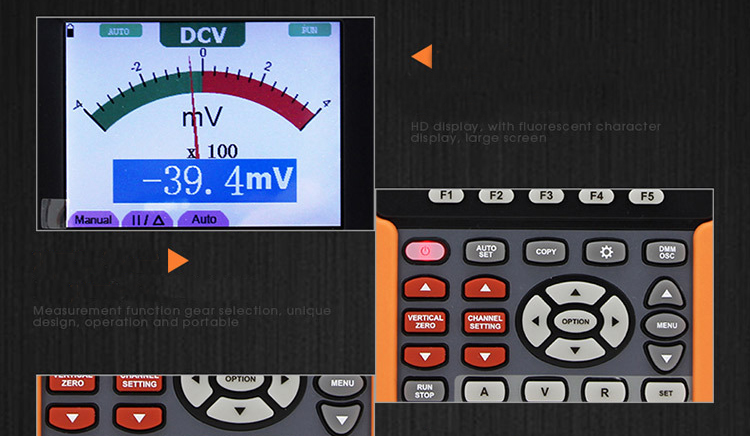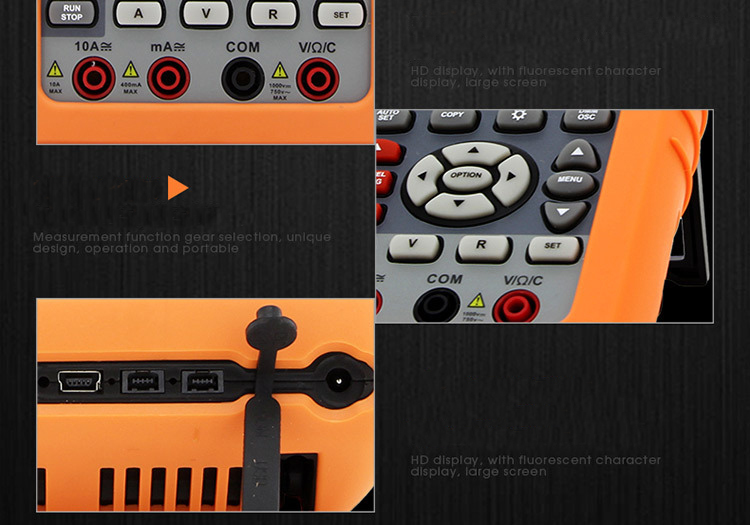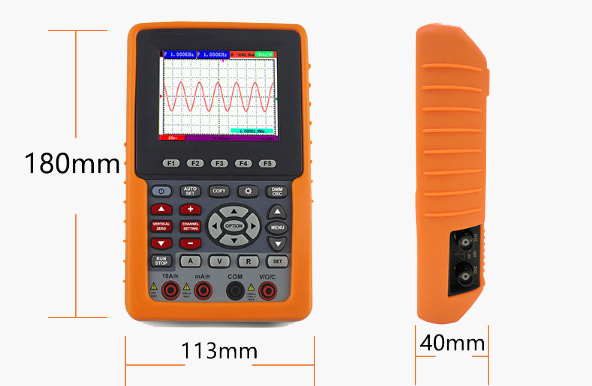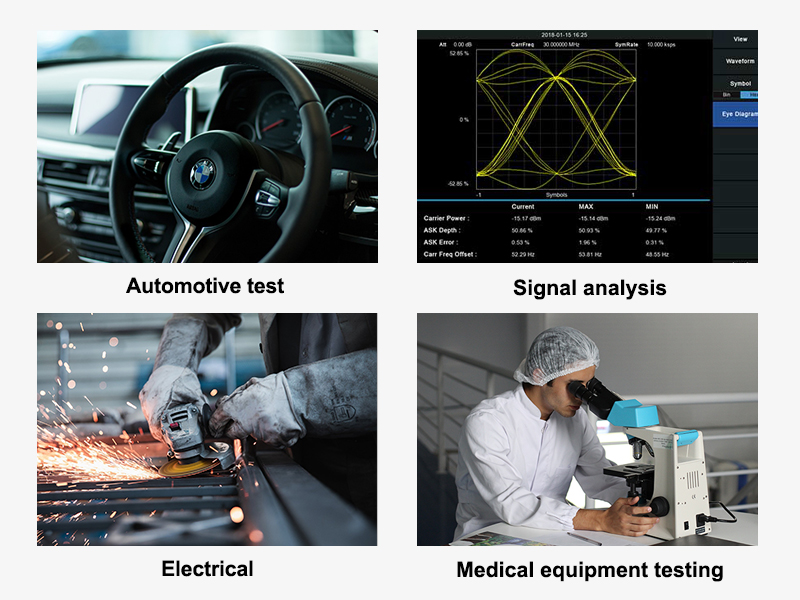The high-quality 100 MHz oscilloscope is a portable tool for waveform measurement, features an auto-scale function, USB data transmission, and waveform record and replay. The single-channel oscilloscope can quickly and accurately detect the faults of the circuit under test and can serve as a assistant, and will provide great convenience for you in work.

High-definition color LCD display, upgrade measurement function keys
- The digital symbols are clearly displayed and the reading is convenient.
- The keys feel good, and the function keys are reasonably distributed design.
- Large LCD display

Test pen jack, charging and USB interface design
- The test pen jack is smooth and fastened, the insertion and removal are good, and there is an upper limit input prompt.
- With a supportable stand, easy to use.
- This unit has a built-in rechargeable battery, no need to worry.
- Can be connected to a computer for online communication.
Dimension Unit (mm)

Application
The main application of a SISCO oscilloscope is used to display the waveforms of signals. It can be used in many fields such as automotive test, signal analysis, electrical, transducer test and measurement, electrical equipment design, medical equipment testing field, etc.

Performance Characteristics
| Model | SISCO-HDS3101M-N |
| Bandwidth | 100 MHz |
| Channel | Single channel |
| Sample rate | 1 GSa/s |
| Horizontal Scale (s/div) |
5ns/div~100s/div, step by 1~2~5 |
| Record length | 24K points |
| Display | 3.7" color TFT display (640 * 480 pixels) |
| Waveform refresh rate | 10000 wfrms/s |
| Input coupling | DC, AC, Ground |
| Input impedance |
1MΩ ± 2%, in parallel with 15pF ± 5pF |
| Probe attenuation | 1X,10X,100X,1000X |
| Max. input voltage | 400V (PK - PK) (DC + AC, PK - PK, 1MΩ input impedance, probe attenuation 10 : 1), CAT II |
| Bandwidth limit(typical) | 20MHz / Full bandwidth |
| Sampling rate range | 5ns/div ~ 500s/div, step by 1 – 2 - 5 |
| DC Accuracy (average) | average >16: ±(5% reading + 0.05div) for △V |
| Vertical Sensitivity | 5mV/div~5V/div (at input) |
| Rise time (at input, Typical) | ≤ 3.5ns |
| Trigger type | Edge and Video |
| Trigger model | Auto, Normal, Single |
| Trigger level range | ±6 div from the screen center |
| Automatic measurement | Vpp, Vavg, Vrms, Freq, Period, Vmax, Vmin, Vtop, Vbase, Vamp, Overshoot, Preshoot, Rise Time, Fall Time, +Width, -Width, +Duty, -Duty, Delay A→B , Delay A→B |
| Cursor measurement | ΔV, ΔT, ΔT&ΔV between cursors,auto cursor |
| Communication interface | USB Type-C |
| Acquisition Mode | Sample, Peak Detect, and Average |
| Interpolation | sin (x) / x |
| Vertical Resolution (A/D) | 8 bits |
| Waveform Storage | 4 waveforms |
| Communication Interface | Mini-USB,mini-RS232 |
| Power Supply | 100V-240V AC, 50/60Hz |
Digital Multimeter Specification
| Full Scale Reading | 3 3/4 digits (max 4000-count) |
| Diode | 0V-1.5V |
| Input Impedance | 10 MΩ |
| On/ Off Test | < 50 (± 30) beeping |
| Voltage | VDC: 400mV, 4V, 40V, 400V, 1000V : ±(1% ± 1 digit); max input: DC 1000V |
| VAC: 4V, 40V, 400V: ±(1% ± 3 digits), 750V: ±(2% ± 3 digits); Frequency: 40Hz - 400Hz; | |
| Max input: AC 750V (virtual value) | |
| Current | DC: 40mA, 400mA : ±(1.5% ± 1 digit), 10A: ±(3% ± 3 digits) |
| AC: 40mA: ±(1.5% ± 3 digits), 400mA: ±(2% ± 1 digit), 10A : ±(5% ± 3 digits) | |
| Impedance | 400Ω: ±(1% ± 3 digits), 40ΚΩ - 4ΜΩ: ±(1% ± 1 digit), 40MΩ: ±(1.5% ± 3 digits) |
| Capacitance | 51.2nF - 100uF: ±(3% ± 3 digits) |
Accessories
- Power cord
- CD rom
- USB cable
- Probe
- Probe Adjust
- Multimeter lead
- Adapter
- User manual
- 5V, 1KHz Output
- Capacitance Ext Module
- Soft Bag
- Metal Case (optional)
Q1: Can an oscilloscope measure DC voltage?
A1: DC voltage can be measured using either an oscilloscope or a digital multimeter. Each piece of testing equipment has its advantages and disadvantages.
Q2: What is the maximum frequency for the oscilloscope?
A2: System bandwidth determines an oscilloscope's fundamental ability to measure an analog signal - the maximum frequency range that it can accurately measure. Entry-level scopes will often have a maximum bandwidth of 100 MHz. They can accurately (within 2%) show the amplitudes of sine-wave signals up to 20 MHz.
Q3: What is the record length for an oscilloscope?
A3: The record length, measured in points or samples, divided by the sample rate (in Samples/second) specifies the total time (in seconds) that is acquired. Example: With a record length of 1 M points and a sample rate of 250 MSa/sec, the oscilloscope will capture a signal of 4 msec in length.
Tips: What should I pay attention to when using a handheld oscilloscope?
- When observing and adjusting the bright spots on the screen, the brightness of the bright spots should be moderate and not too bright.
- The voltage of "Y input" should not be too high, so as not to damage the instrument, and it should not exceed 400V during large attenuation. 6. Before shutting down, turn the brightness adjustment knob to the end counterclockwise to reduce the brightness, and then turn off the power switch.
The handheld oscilloscope can transform invisible electrical signals into visible images, which is convenient for people to study the changing process of various electrical phenomena. Oscilloscopes use a narrow beam of high-speed electrons to strike a phosphor-coated screen to produce tiny spots of light. Under the action of the measured signal, the electron beam is like the tip of a pen, which can depict the change curve of the instantaneous value of the measured signal on the screen.
Thank you for buying industrial test and measurement equipment on SISCO.com, all products sold by SISCO and the partner cover a 12 months warranty, effective from the date of receiving the products.
What is covered?
SISCO is responsible for providing free spare parts, and free technical support to assist the customer to repair the defective products until the problem is solved.
What is not covered?
- Product purchased from anyone other than a SISCO store or a SISCO authorized reseller.
- Expendable parts.
- Routine cleaning or normal cosmetic and mechanical wear.
- Damage from misuse, abuse or neglect.
- Damage from use of parts other than SISCO approved.
- Damage from use outside the product’s usage or storage parameters.
- Damage from use of parts not sold by SISCO.
- Damage from modification or incorporation into other products.
- Damage from repair or replacement of warranted parts by a service provider other than a SISCO authorized service provider.
- Damage caused by the application environment not meeting the product usage requirements and the failure to perform preventive maintenance.

